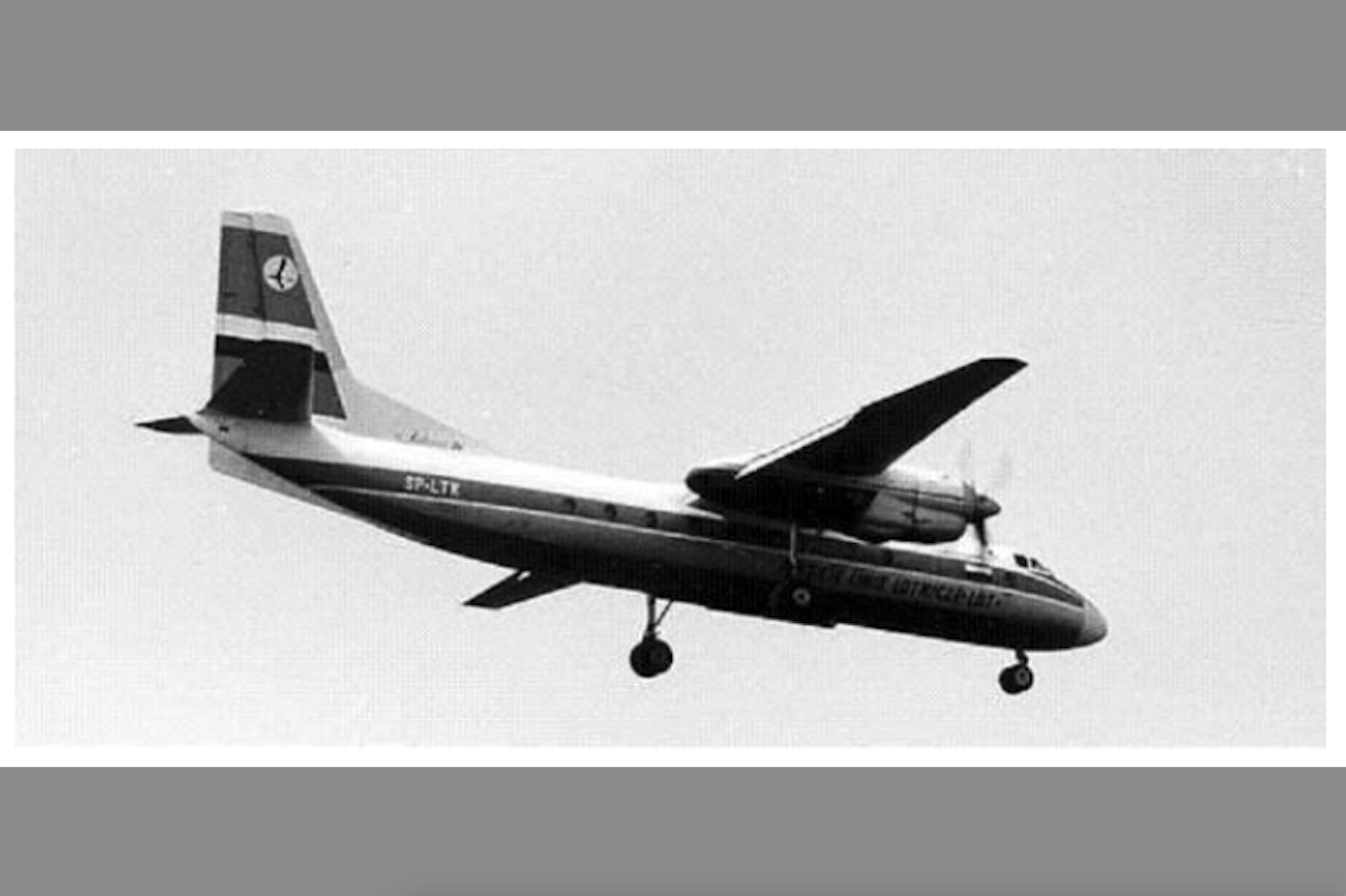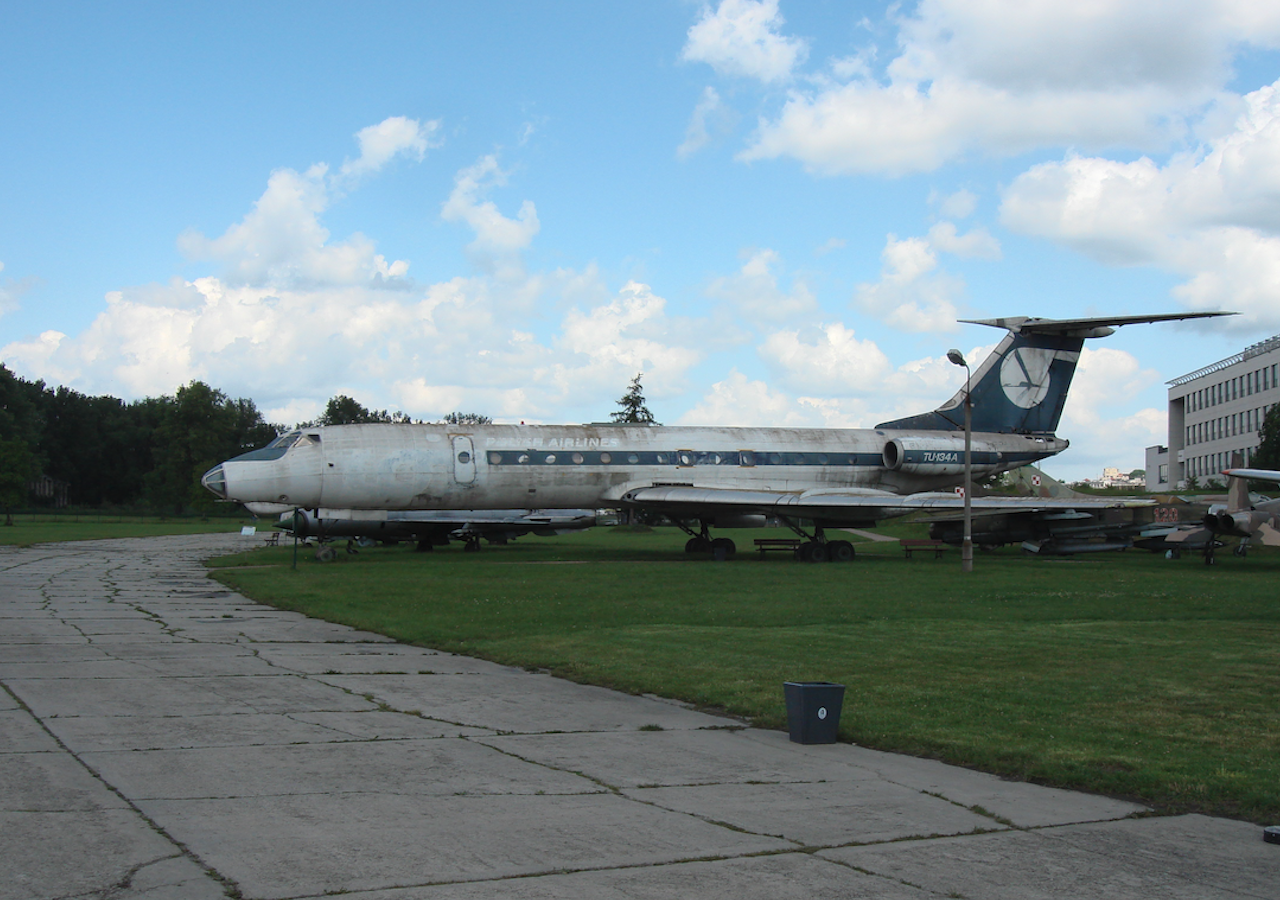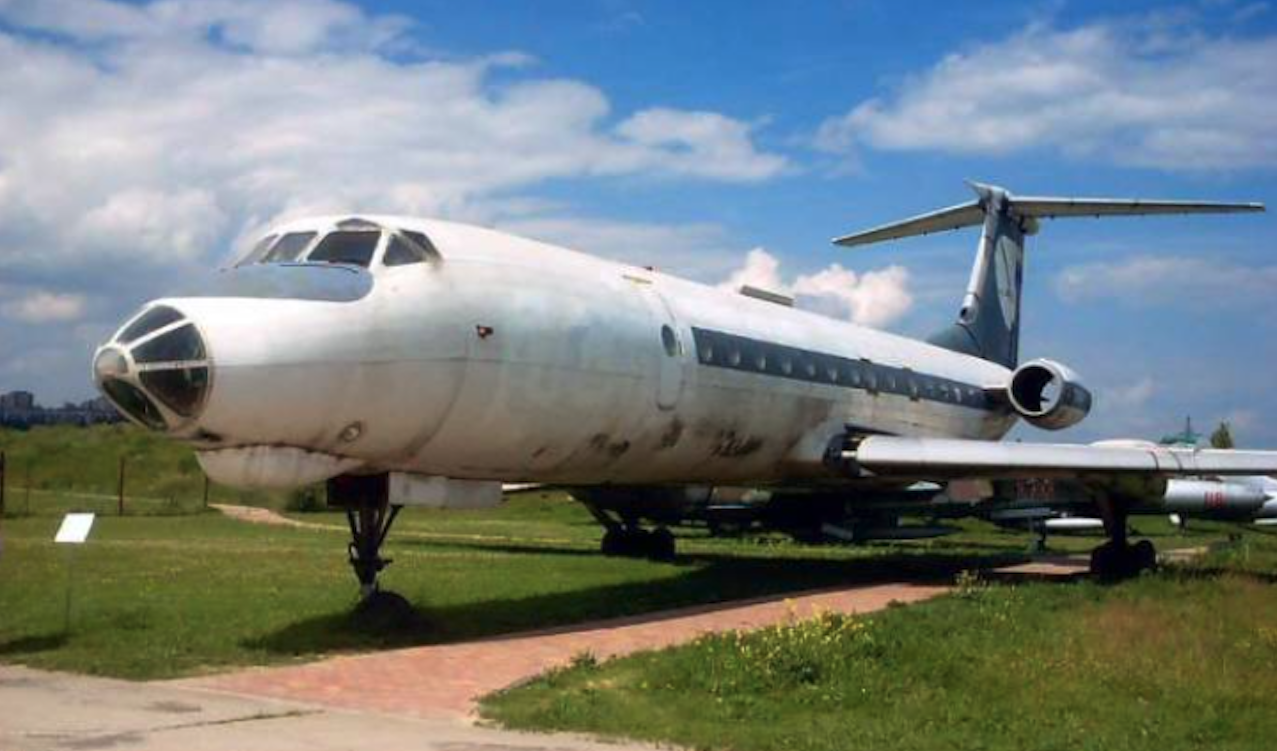Warszawa 2014-04-15
Historia Polskich Linii Lotniczych LOT.
Cześć 3. 1963r.-1987r.
1963 rok.
Samoloty o stosunkowo dużym zasięgu, posiadane przez PLL LOT, pozwoliły na uruchomienie kolejnych dalekich połączeń. W 1963 roku, PLL LOT uruchamia kolejne pozaeuropejskie połączenia lotnicze:
Warszawa-Bagdad, Irak – 2 816 km, 1 750mil, 1 521 NM.
Warszawa-Bejrut, Liban – 2 347 km, 1 458 mil, 1 267 NM.
Warszawa-Bengazi, Libia – 2 240 km, 1 392 mil, 1 210 NM.
Warszawa-Damaszek, Syria – 2 417 km, 1 502 mil, 1 305 NM.
Warszawa-Tunis, Tunezja – 1 915 km, 1 190 mil, 1 034 NM.
1966 rok.
W marcu 1966 roku, PLL LOT przyjął na swoje wyposażenie dwusilnikowe, turbośmigłowe samoloty typu Antonow An-24 W. Maszyn było łącznie z samolotami przekazanymi przez wojsko około 20 sztuk. Zastąpiły samoloty Li-2, Ił-14. Były eksploatowane głównie na liniach krajowych. Z początkiem 1990 roku, zaczęły być zastępowane przez samoloty ATR-42. Ich definitywna eksploatacja zakończyła się w 1992 roku, a część maszyn sprzedano. Przez prawie 26 lat samolot An-24 W był podstawowym samolotem pasażerskim na trasach krajowych, łącząc następujące lotniska; Okęcie, Gdańsk-Wrzeszcz, Gdańsk-Rębiechowo, Balice, Wrocław-Starachowice, Poznań-Ławica, Szczecin-Goleniów, Koszalin-Zegrze Pomorskie, Słupsk, Rzeszów.
Niestety, z udziałem tych samolotów wydarzyły się w Polsce trzy katastrofy z ofiarami w ludziach. Najtragiczniejszy były wypadek w dniu 2.04.1969 roku, w Paśmie Babiogórskim, niedaleko Zawoi. Zginęły 53 osoby. Wszyscy na pokładzie samolotu.
1968 rok.
W 1968 roku, w PLL LOT rozpoczęła się era samolotów z napędem turboodrzutowym. Decyzja o kupnie przez Polskę samolotów typu Tupolew Tu-134 dla PLL LOT zapadła w 1967 roku i ujęto to w budżecie na 1968 rok.
Na początku podjęto decyzję o zakupie 5 maszyn typu Tu-134 w pierwszej wersji eksportowej z oszklonym nosem. Pierwsze dwa samoloty dostarczono do Polski w dniu 6.11.1968 roku, a były to; Tu-134 nr 8350602 SP-LGA Ignacy Paderewski oraz Tu-134 nr 8350603 SP-LGB Władysław Reymont. Były to pierwsze turboodrzutowe samoloty transportowe użytkowane w Polsce. Przyjęto je niezwykle uroczyście i dlatego dano im nazwy własne. Pierwszy z tych samolotów w czerwcu 1982 roku, został wycofany z użytkowania i sprzedany Aerofłotowi (CCCP-65933). Drugi w dniu 23.01.1980 roku, podczas lądowania na lotnisku Okęcie na DS 11 (RWY 11) doznał uszkodzenia prawego skrzydła, co wywołało pożar. Na szczęście nikomu nic się nie stało, a samolot został skasowany. Był to jedyny przypadek zdarzenia lotniczego z udziałem Polskich Tu-134 mogącego zakończyć się tragicznie.
Kolejne trzy Tu-134 otrzymaliśmy na przełomie kwietnia-maja 1969 roku; SP-LGC nr 9350804 Maria Skłodowska-Curie, SP-LGD nr 9350805 Ludwik Zamenhoff oraz SP-LGE nr 9350806 Ignacy Domeyko. Samoloty te dobrze służyły w PLL LOT do czerwca 1982 roku, kiedy to razem z SP-LGA sprzedano je Aerofłotowi. Otrzymały one tam odpowiednio rejestracje; CCCP-65923, CCCP-65922, CCCP-65924.
Te pierwsze pięć maszyn w trakcje użytkowania w Polsce przeszły modernizację. Otrzymały nowsze środki łączności. Można to było łatwo rozpoznać po żądle na usterzeniu zamiast długiej linki biegnącej do przodu kadłuba.
W 1972 roku, zapadły decyzje o zakupie kolejnych maszyn typu Tu-134, tym razem w wersji A. Maszyny te otrzymały przedłużony o 2,10 m kadłub i zostały wykonane w układzie 84 miejsc (konfiguracja Y76). Poza tym zewnętrznie niewiele różniły się od dotychczas użytkowanych. Pierwsze trzy maszyny otrzymaliśmy na przełomie marzec-kwiecień 1973 roku; SP-LHA nr 3351808 Paweł Strzelecki, SP-LHB nr 3351809 Józef Bem, SP-LHC nr 3351810 Janusz Kusociński. Pierwszy (SP-LHA) z nich był eksploatowany do czerwca 1993 roku. Przekazany nieodpłatnie, jako złom samolotowy dla JW. 2305 w Warszawie. Odebrany 18.09.1997 roku. Samolot SP-LHB zakończył służbę w czerwcu 1992 roku i został przekazany nieodpłatnie, jako złom samolotowy dla Muzeum Lotnictwa Polskiego w Krakowie. Odebrany 25.10.1999 roku i do dnia dzisiejszego (2021 roku) jest największym eksponatem w Muzeum w Czyżynach. Samolot SP-LHC zakończył służbę w marcu 1993 roku. Sprzedany, jako złom samolotowy dla Komendy Stołecznej Policji w Warszawie. Odebrany 10.10.1997 roku. Ustawiono go na policyjnym poligonie przy alejach Jerozolimskich w Warszawie, ulica Mszczonowska, przy Reducie, gdzie obecnie (2005 roku) jest wykorzystywany do szkolenia oddziałów antyterrorystycznych policyjnych i Wojskowej Formacji Specjalnej Grom.
Kolejne dwa Tu-134 A, PLL LOT otrzymał w czerwcu 1976 roku; SP-LHD nr 48400, SP-LHE nr 48405. Samoloty te już nie otrzymały nazw własnych. Samolot SP-LHD wycofano w lipcu 1994 roku.
Samolot SP-LHD dzięki staraniom byłego pana dyrektora inż. Czesława Czujowskiego trafił do Lotniczych Zakładów Naukowych we Wrocławiu w 1998 roku ( przekazany 13.12.1997 roku ). Tutaj również pokryto tylko kosztu transportu. Ustawiono obok boiska szkolnego na ul. Kiełczowskiej 43. Samolot był w pełni kompletny z wyjątkiem silników. Aktualnie samolotu już nie ma. W 2002 roku, został pocięty na złom.
Samolot SP-LHE zakończył służbę w listopadzie 1993 roku. Przekazany został nieodpłatnie, jako złom samolotowy dla Muzeum – Wystawy Sprzętu Lotniczego i Wojskowego w Łodzi Lublinku. Odebrany 15.03.1998 roku. Po likwidacji muzeum dalsze lost samolotu nie są znane.
W 1968 roku, PLL LOT uruchomił nowe połączenia; Warszawa-Kijów, Warszawa-Istambuł, Turcja – 1 386 km, 861 mil, 749 NM.
W 1969 roku, na Lotnisku Okęcie otwarto nowy dworzec lotniczy. Patrz artykuł Lotnisko Okęcie.
1972 rok.
W socjalistycznej Polsce, w 1970 roku, doszło do niepokojów i rozruchów społecznych. Szczególnie na Wybrzeżu w Gdańsku. Władzę przejęła nowa ekipa partyjna z pierwszym sekretarzem PZPR Edwardem Gierkiem. Polska częściowo otworzyła się na świat. Od drugiej wojny światowej minęło już 25 lat. Polska emigracja coraz częściej pragnęła odwiedzić Ojczyznę, a i Polscy mieszkający w kraju chcieli odwiedzić swoich bliskich za Wielką Wodą. W tej sytuacji KC PZPR zdecydowało, że Polskie Linie Lotnicze LOT wstąpią do ekskluzywnego klubu przewoźników transatlantyckich.
Dzisiaj (2021 rok) wydaje się, że nie było to nic specjalnego. Jeśli ktoś tak sądzi, to jest w wielkim błędzie. To było naprawdę coś niezwykłego. Przed Edwardem Gierkiem władze w PRL sprawował Wiesław Gomułka. W jego czasach takie posuniecie nie mieściło się w głowie. Jego zdaniem kontakty ze światem kapitalistycznym powinny być ograniczane do minimum. Jeśli chodzi o loty za granice, dopuszczał tylko loty do paru stolic Europy Zachodniej. Uznając to i tak za luksus. W jego mniemaniu zakup dla PLL LOT maszyn produkcji Zachodniej był nie do pomyślenia. Nic więc dziwnego, że oferty sprzedaży Boeing 707 czy DC-8, które w tym czasie królowały nad Atlantykiem, lądowały w koszu.
W 1972 roku, Polska kupiła pierwszy samolot przystosowany do pokonywania dalekich tras. Uwarunkowania polityczne wskazywały tylko na jedyną ofertę, jaką był samolot Iliuszyn Ił-62 z OKB Iliuszyna, nadal kierowanego przez sędziwego już Siergieja W. Iliuszina. W marcu 1972 roku, do Polski dostarczono pierwszego Ił-62 SP-LAA Mikołaj Kopernik. Kilkumiesięczne szkolenie załogi nowych samolotów przeszły w CCCP. Prowadzono je na lotnisku Szeremietiewo koło Moskwy. Ogółem do floty PLL LOT wcielono 7 samolotów Ił-62. Wszystkim tym samolotom nadano imiona znanych Polaków. IŁ-62: SP-LAA ( Nr 11004 ) Mikołaj Kopernik. SP-LAB ( Nr 21105 ) Tadeusz Kościuszko. SP-LAC ( Nr 31401 ) Fryderyk Chopin. SP-LAD ( Nr 41604 ) Kazimierz Pułaski. SP-LAE ( Nr 41802 ) Henryk Sienkiewicz. SP-LAF ( Nr 62204 ) Adam Mickiewicz. SP-LAG ( Nr 2725456 ) Maria Skłodowska-Curie.
Chrzest Polskiego Ił-62 SP-LAA Mikołaj Kopernik nastąpił w dniu 16.04.1973 roku, kiedy to z kompletem pasażerów udał się z Warszawy do New York (6 862 km, 4 264 mil, 3 705 NM).
Rozwinęła się siatka lotów czarterowych. W 1976 roku, pierwszy rejs na Daleki Wschód do Bangkoku, Tajlandia przez Dubaj, ZEA i Bombaj, Indie. (8 100 km, 5 033 mil, 4 374 NM). Do 1979 roku, samoloty Ił-62 latały już regularnie do Kuwejtu, Trypolisu i Algieru: Warszawa-Kuwejt, Kuwejt – 3 373 km, 2 096 mil, 1 821 NM. Warszawa-Trypolis, Liban – 2 307 km, 1 433 mil, 1 245 NM. Warszawa-Algier, Algieria – 2 224 km, 1 382 mil, 1 201 NM. Wykonywano także loty czarterowe do Sydney, Australii (wykonywane etapami; 15 612 km, 9 701 mil, 8 430 NM) i do Tokyo, Japonia (8 590 km, 5 337 mil, 4 638 NM). Wszystkie te loty odbywano samolotami Ił-62.
W 1978 roku, artyści plastycy Roman Duszek i Andrzej Zbrożek opracowali nową szatę graficzną dla samolotów LOT-u: kadłub samolotu malowany na biało, w przedniej części umieszczony duży, pisanego kursywą pochyloną w prawą stronę, granatowy napis LOT połączony z granatowym pasem biegnącym wzdłuż kadłuba, na usterzeniu pionowym umieszczono żurawia i Polską flagę. Zmiana szaty samolotów PLL LOT była związana z obchodzonym w 1979 roku, jubileuszem 50-lecia narodowego przewoźnika.
Dobra passa Polskich Ił-62 skończyła się w dniu 14.03.1980 roku, wraz z katastrofą samolotu SP-LAA Mikołaj Kopernik. W katastrofie zginęła cała załoga i wszyscy pasażerowie samolotu, łącznie 87 osób. Cześć Ich pamięci ! Cała katastrofa opisana jest w osobnym Rozdziale. Winni katastrofy byli Rosjanie, którzy niechlujne wykonywali remont silnika. W efekcie tej katastrofy wymieniono wszystkie samoloty Ił-62 na Ił-62 M. Do floty PLL LOT wcielono łącznie 9 maszyn w wersji zmodernizowanej Ił-62 M; SP-LBA ( Nr 2932526 ) Juliusz Słowacki. SP-LBB ( Nr 1034152 ) Ignacy Paderewski. SP-LBC ( Nr 3036253 ) Joseph Conrad-Korzeniowski. SP-LBD ( Nr 1138234 ) Gen. Władysław Sikorski. SP-LBE ( Nr 1138546 ) Stanisław Moniuszko. SP-LBF ( Nr 2343554 ) Fryderyk Chopin. SP-LBG ( Nr 3344942 ) Tadeusz Kościuszko. SP-LBH ( Nr 1748445 ). SP-LBI ( Nr 4831739 ).
Niewiele to pomogło, bo w dniu 9.05.1987 roku, Ił-62 M SP-LBG Tadeusz Kościuszko rozbił się w Lesie Kabackim. Zginęły 183 osoby, wszyscy znajdujący się na pokładzie samolotu. Cześć Ich pamięci ! Jest to do chwili obecnej (2021 rok) największa katastrofa w PLL LOT. Przyczyna była podobna. Niewłaściwy remont silnika przez Rosjan.
1974 rok.
W PLL LOT zorganizowano Oddział Lotów Wynajętych, które zajmowało się organizacją rejsów czarterowych. Dział funkcjonował przez ponad 30 lat. Uruchomiono kilka sezonowych połączeń z Polskich Lotnisk Regionalnych za granicę. Wśród nich z Krakowa do Warny, Bułgaria. Loty te zawieszono z chwilą wprowadzenia stanu wojennego i już do nich nie powrócono.
1981 rok.
Z powodu wprowadzenia przez generała Wojciecha Jaruzelskiego, w dniu 13.12.1981 roku, stanu wojennego, zawieszone zostały wszystkie loty samolotów PLL LOT, a samoloty zagraniczne nie były wpuszczane do Polski. Wiosną 1982 roku, PLL LOT ponownie uruchomił połączenia krajowe. Pasażerów było niewielu, bo oprócz biletu należało posiadać specjalną przepustkę. Na pokładzie, zawsze było co najmniej dwóch, uzbrojonych w długą broń, funkcjonariuszy ZOMO. Stan wojenny został zawieszony w dniu 31.12.1982 roku, a zniesiony 22.07.1983 roku, na komunistyczne święto. Dopiero w 1983 roku, PLL LOT wznowił połączenia europejskie. Pierwsze loty do New York i Chicago wznowiono w 28.04.1984 roku.
1984 rok.
Zostały uruchomione nowe trasy PLL LOT, odbywane etapami; Warszawa-New Delhi, Indie – 5 269 km, 3 274 mil, 2 845 NM. Warszawa-Pekin, Chiny – 6 948 km, 4 317 mil, 3 752 NM.
1985 rok.
Sytuacja gospodarcza w PRL i całym wschodnim kołchozie europejskim, z każdym miesiącem się pogarsza. Coraz trudniej było utrzymać w pełnej sprawności wyeksploatowane już samoloty Ił-18 i Tu-134. Ratując sytuację, PLL LOT używał samoloty Jak-40 należące do 36. Specjalnego Pułku Lotnictwa Transportowego. W 1986 roku, zapadła decyzja o wycofaniu z eksploatacji samolotów Ił-18 i Tu-134. W ich miejsce wprowadzono nowe samoloty Tu-154 M.
W maju 1985 roku, do PLL LOT trafiły dwa samoloty Tu-154 B-2. Samoloty otrzymały barwy firmy LOT, ale rejestracje miały rosyjskie. Pierwszy był CCCP-85331 nr 79A-331. Miał 164 miejsca pasażerskie. Latał w LOT do września 1988 roku. Następnie latał jako EW-85331 Belavia. Drugim był Tu-154 B-2 rejestracja CCCP-85455 nr 80A-455. Zabierał na pokład 164 pasażerów. Eksploatowany od maja 1985 roku, do października 1988 roku. W dniu 21.01.1995 roku, został skasowany po wypadku w Karaczi.
W maju 1986 roku, Aerofłot wypożyczył trzeci samolot Tu-154 B-2 rejestracja CCCP-85334 nr 79A-334, także dla 164 pasażerów. Samolot LOT eksploatował tylko do czerwca 1986 roku, a więc niecałe dwa miesiące. Później jako RA-85334 był w Aerofłot i Pułkowo Airlines.
1986 rok.
Przeprowadzone przez PLL LOT analizy spowodowały podjęcie decyzji o zakupie samolotów Tu-154 M. W maju 1986 roku, do Polski przyleciał pierwszy kupiony Tu-154 M rejestracja SP-LCA nr 86A-727. Samolot miał konfigurację 150 miejscową. Uprzedzając fakty napiszemy, że był eksploatowany przez PLL LOT do lipca 1995 roku. Później 4K-727 Turan Air, LZ-LCS Bulgarian Air Charter.
Pomimo dostarczenia pierwszego Tu-154 M strona Polska miała liczne uwagi, które strona moskiewska uwzględniła i wprowadziła zmiany w SP-LCD, który stał się wzorcem, a poprzednie, czyli SP-LCA, SP-LCB oraz SP-LCC doprowadzono podczas remontów do tego standardu. W sierpniu 1986 roku, przyleciał kolejny samolot Tu-154 M SP-LCB, eksploatowany w LOT do lipca 1995 roku, później 4K-733 Turan Air, LZ-HMP Hemus Air, LZ-LCV Bulgarian Air Charter. Kolejnym dostarczonym w marcu 1987 roku, był SP-LCC, użytkowany do grudnia 1996 roku, później RA-85827 Buryatia Airlines i Enkor. Pod koniec sierpnia 1987 roku, do Polski przyleciał Tu-154 M rejestracja SP-LCD nr 87A-755. Był to już czwarty z 14 zakontraktowanych samolotów Tu-154 M dla PLL LOT. Nie było to nic nadzwyczajnego, lecz była to maszyna wzorcowa dla wszystkich maszyn przeznaczonych dla Polski.
Co wyróżniło ten samolot od trzech poprzednich? Po pierwsze, wszystkie napisy na samolocie włącznie z kabiną załogi były w Języku Polskim. Samolot otrzymał konfigurację 150 miejscową; 52 miejsca w przedniej kabinie o podwyższonym standardzie gdyż jest większa odległość między rzędami. W drugiej kabinie 98 foteli, jako klasa turystyczna. Stali podróżni od razu zauważyli nowy system oznaczeń rzędów i foteli. Czytelne napisy. Czytelne instrukcje systemu bezpieczeństwa. Nowe dużo lepsze oświetlenie kabiny pasażerskiej. Projektantem oznaczeń była artysta plastyk Krystyna Żmijewska-Borowicz. Samolot już w czasie produkcji otrzymał możliwość przewożenia towarów. W komplecie były specjalne wózki do przewożenia towarów, urządzenia do mocowania ładunku na pokładzie, rolkowe osłony podłogi i osłony burt. Dopuszczalny ładunek handlowy zwiększono o 1 000 kg do 19 000 kg. Wybrane rejony konstrukcji płatowca zabezpieczono preparatami antykorozyjnymi produkcji szwedzkiej. Samolot otrzymał nowy system ewakuacji w postaci 6 nadmuchiwanych trapów nowego typu w miejscu poprzednich 5 trapów i jednej rynny. Trapy są zbliżone do tych produkowanych przez brytyjska firmę RFD. Są one dwukrotnie lżejsze. Mają dużo łatwiejszą obsługę. Wystarczy je tylko wyrzucić na zewnątrz. Reszta dzieje się automatycznie. Napełniają się azotem. Ten szósty trap zamiast rynny to była inicjatywa LOT, choć obyło się to kosztem jednego miejsca pasażerskiego. Radykalnie zmieniła się kuchnia-bufet. Teraz na pokładzie rozmieszczono 3 bufety zamiast jednego w środku. Bufety wyposażono w sprzęt produkcji zachodniej. Projekty bufetów wykonali Polscy inżynierowie; Jacek Paradowski i Jacek Kowalczyk. Projekt zyskał uznanie w zakładzie w Kujbyszewie i wśród towarzystw eksploatujących samoloty Tu-154. Przestrzeń dla przedniego bufetu uzyskano likwidując 3 miejsca pasażerskie. Dzięki nowym bufetom catering na pokładzie był znacznie efektywniejszy. Teraz jest 10 wózków, a były tylko dwa. Jest 29 pojemników na posiłki, a było tylko 10. Są 2 szafy chłodnicze, a była tylko 1 lodówka. Jest 11 podgrzewaczy wody, a był 1 duży zbiornik z 1 podgrzewaczem. Jest 7 podgrzewaczy potraw, a było 5 piekarników. Jest dużo większy pojemnik do lodu. Dzięki większym bufetom można teraz zabrać prowiant także na drogę powrotną, co obniża koszty i ułatwia obsługę w obcych portach. Uzyskano także możliwość serwowania bardziej urozmaiconego jedzenia. Więcej miejsca to także większy asortyment dla pokładowego sklepu firmy Baltony.
Jak widzimy wiele uczyniono dla pasażerów. Ale także w kabinie załogi były zmiany. Samolot otrzymał system dalekiej nawigacji złożony z dwóch zestawów Omega firmy kanadyjskiej. System jest połączony z automatycznym pilotem. Dodatkowo zamontowano nowy układ wywołania radiowego załogi połączony z radiostacjami Mikron i Bałkan. Samolot SP-LCD otrzymał lotny kod LM-JP. Układ jest dźwiękowy ( selektywny o 16 tonach ) i świetlny. Jest to urządzenie produkcji USA najnowszej generacji. Kolejna zmiana to dwa, a nie jeden wskaźnik radioodległościomierza przed każdym z pilotów. Na tablicy przyrządów zmieniono rozmieszczenie niektórych wskaźników. Rejestrator parametrów lotów, tak zwana czarna skrzynka otrzymała dodatkowe ścieżki na zapis temperatur gazów wylotowych i temperatury otoczenia. Zmieniono także parametr niebezpiecznej wibracji silnika, który był punktowy, na przekroczenie zwiększonej wibracji silnika, czyli pomiar ciągły od pewnego progu.
Wszystkie te zmiany były wynikiem współpracy PLL LOT (wspartego Polskimi Instytutami) i Aviaexportem, reprezentujący stronę producenta i władz na Kremlu. Samolot SP-LCD latał w LOT do sierpnia 1997 roku, później RA-85829 Buryatia Airlines i Enkor.
Niestety, w dniu 9.05.1987 roku, doszło do kolejnej tragedii samolotu PLL LOT. Tym razem katastrofie uległ Ił-62 M napędzany silnikami D-30 KU, czyli identycznymi z tymi używanymi w Tu-154 M. Oczywiście musiało to zatrząść podstawami porozumienia, choć transakcję wykonano do końca. W 1988 roku, dostarczono kolejne cztery Tu-154 M; SP-LCE, SP-LCF, SP-LCG, SP-LCH. W 1989 roku, kolejne trzy Tu-154 M; SP-LCI, SP-LCK, SP-LCL. W 1990 roku, jeszcze dwa Tu-154 M; SP-LCM, SP-LCN. W 1991 roku, pojawił się jeszcze jeden Tu-154 M SP-LCO, ale o trafił do Wojska Polskiego.
Samoloty Tu-154 dostarczono do Polski, a wśród kierownictwa PLL LOT i w Rządzie Rzeczypospolitej trwała dyskusja, co z nimi zrobić, a dokładniej jak się ich pozbyć. Polska przechodziła zmiany społeczno-ustrojowe i społeczeństwo miało już dojść jedynie słusznej techniki. Tym bardziej, że Boeing 767 spisywały się w LOT doskonale. Jedynym argumentem przeciwników, były straty finansowe, jakie poniesie PLL LOT, a dokładniej społeczeństwo, po sprzedaniu niechcianych maszyn. Bardzo szybko okazało się jednak, że nawet sprzedanie samolotów za połowę ich wartości to i tak Polska wyjdzie na swoje, nie mówiąc o ewentualnej lotniczej katastrofie.
Podjęto decyzję, o wystawieniu maszyn na sprzedaż. LOT zakończył loty rejsowe Tu-154 M w 1993 roku, a sporadyczne loty czarterowe w 1996 roku. Samolotów pozbyto się, a większość z nich trafiła do Rosji. Wszak w porównaniu z ich Tu-154 miały dużo lepszy standard wykonania i wyposażenia. Strach myśleć, czym oni tam latają.
W 1987 roku, PLL LOT zatrudniało 5 891 pracowników. Obsługiwało linie wewnętrzne, w Europie, do Ameryki północnej, Afryki Północnej, Bangkoku i na Środkowy Wschód. W 1980 roku, firma przewiozła 1 827 572 pasażerów. Flota: 9 samolotów Iliuszyn Ił-18, 6 samolotów Iliuszyn Ił-62, 5 samolotów Iliuszyn Ił-62 M, 4 samoloty Tupolew Tu-134, 7 samolotów Tupolew Tu-134 A, 16 samolotów Antonow An-24.
Opracował Karol Placha Hetman



